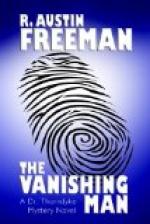“How good of you, Berkeley,” he said, shaking hands genially, “to look me up so early. I am all alone, just looking through the report of the evidence in yesterday’s proceedings.”
He placed an easy chair for me, and, gathering up a bundle of type-written papers, laid them aside on the table.
“Were you surprised at the decision?” I asked.
“No,” he answered. “Two years is a short period of absence; but still, it might easily have gone the other way. I am greatly relieved. The respite gives us time to carry out our investigations without undue hurry.”
“Did you find my notes of any use?” I asked.
“Heath did. Polton handed them to him, and they were invaluable to him for his cross-examination. I haven’t seen them yet; in fact, I have only just got them back from him. Let us go through them together now.”
He opened a drawer, and taking from it my note-book, seated himself, and began to read through my notes with grave attention, while I stood and looked shyly over his shoulder. On the page that contained my sketches of the Sidcup arm, showing the distribution of the snails’ eggs on the bones, he lingered with a faint smile that made me turn hot and red.
“Those sketches look rather footy,” I said; “but I had to put something in my note-book.”
“You didn’t attach any importance, then, to the facts that they illustrated?”
“No. The egg-patches were there, so I noted the fact. That’s all.”
“I congratulate you, Berkeley. There is not one man in twenty who would have the sense to make a careful note of what he considers an unimportant or irrelevant fact; and the investigator who notes only those things that appear significant is perfectly useless. He gives himself no material for reconsideration. But you don’t mean that these egg-patches and worm-tubes appeared to you to have no significance at all?”
“Oh, of course, they show the position in which the bones were lying.”
“Exactly. The arm was lying, fully extended, with the dorsal side uppermost. There is nothing remarkable in that. But we also learn from these egg-patches that the hand had been separated from the arm before it was thrown into the pond; and there is something very remarkable in that.”
I leaned over his shoulder and gazed at my sketches, amazed at the rapidity with which he had reconstructed the limb from my rough drawings of the individual bones.
“I don’t quite see how you arrived at it, though,” I said.
“Well, look at your drawings. The egg-patches are on the dorsal surface of the scapula, the humerus, and the bones of the fore-arm. But here you have shown six of the bones of the hand: two metacarpals, the os magnum, and three phalanges; and they all have egg-patches on the palmar surface. Therefore the hand was lying palm upwards.”
“But the hand may have been pronated.”




